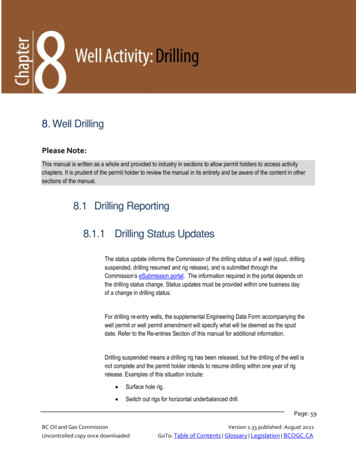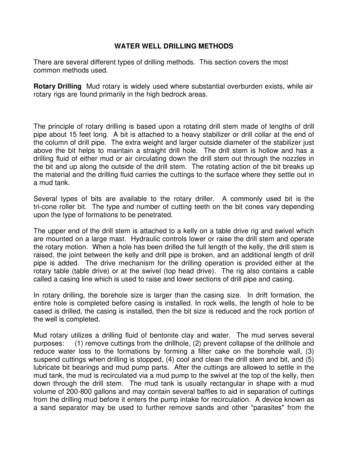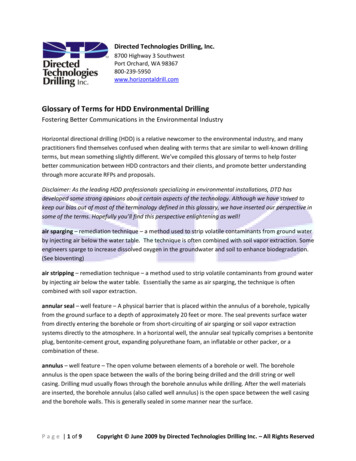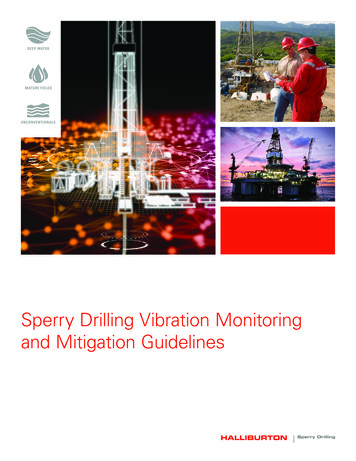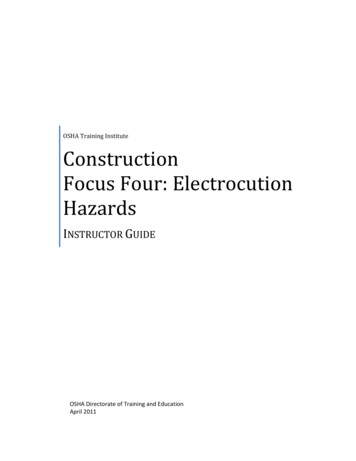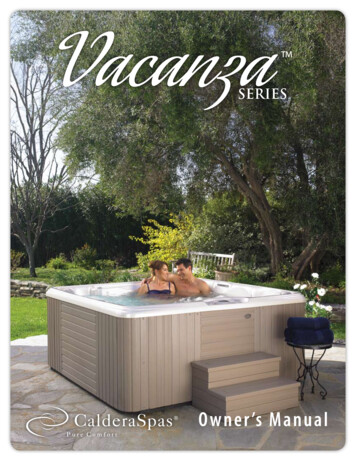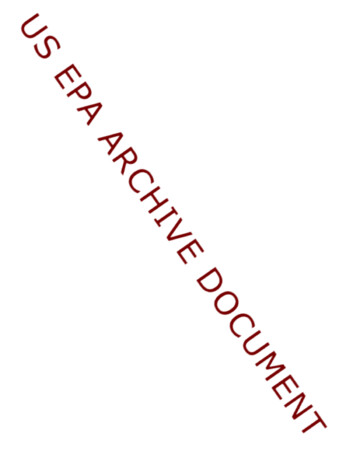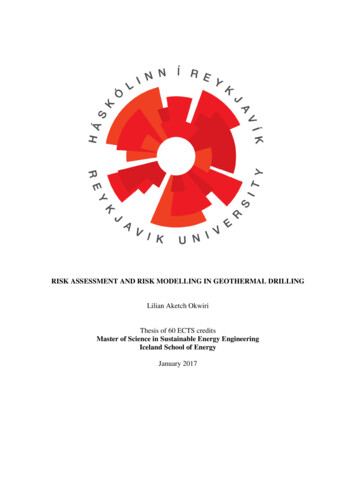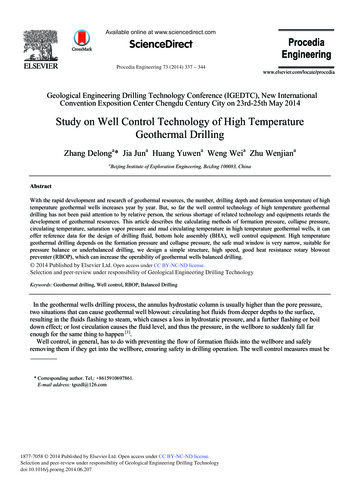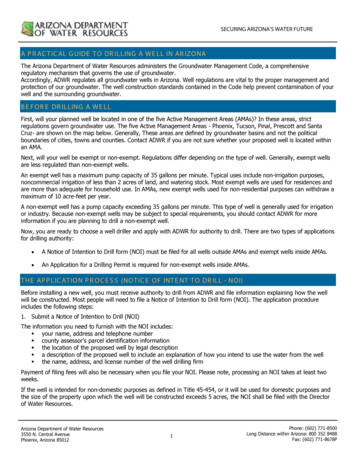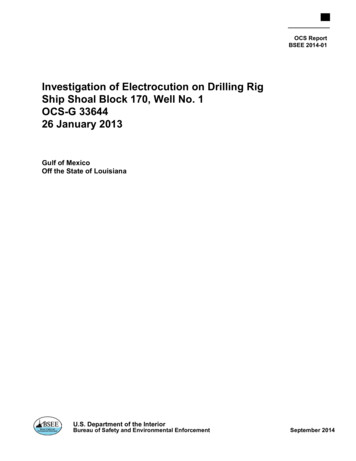
Transcription
OCS ReportBSEE 2014-01Investigation of Electrocution on Drilling RigShip Shoal Block 170, Well No. 1OCS-G 3364426 January 2013Gulf of MexicoOff the State of LouisianaU.S. Department of the InteriorBureau of Safety and Environmental EnforcementSeptember 2014
OCS ReportBSEE 2014-01Investigation of Electrocution on Drilling RigShip Shoal Block 170, Well No. 1OCS-G 3364426 January 2013Gulf of MexicoOff the State of LouisianaJack Williams – ChairCharles ArnoldJim HailPaul NelsonJames RichardU.S. Department of the InteriorBureau of Safety and Environmental EnforcementSeptember, 2014
ContentsExecutive 6Objective, Well Permit, and Rig6Objective, Well PermitRig66Description of Cementing Unit and ProcessPersonnel911Bois d’ArcSpartan RigsBaker Hughes111212Rig Activities – Timeline Prior to the Incident15Baker Hughes Personnel – Activities Prior to the Incident16Physical Elements, Actions – Timeline After the Incident20Emergency Procedures, Evacuation, Coroner’s ReportIncident Related GeographyTimeline, Post-IncidentElectric Power Provided to Skid20212631Power from Rig SupplyAppleton Dual Outlet Receptacle3133Skid Electric Power Distribution and Instrumentation35Primary Power Source (Inoperative)37Backup Power Circuit38Extension CordBattery BoxInlet Receptacle384142Rig Battery Charger48Operating Manual/User’s Guides: Dangers and Warnings, Battery Chargers51Situation at Time of Incident52Subject Matter Expert Group’s Report53Extension Cord Use in Industrial Application – Best Practice54API RP 14F55i
OSHA Regulations and DiscussionElectrical Safety Foundation InternationalULConsumer Product Safety CommissionOther Extension Cord Notes5658585859Electric Shock and the Human Body60Electrocution Hazards and Ground Fault Circuit Interrupters (GFCIs)61Safety Alerts63Baker Hughes Safety AlertSpartan Rigs Safety Alert6366Potential Enforcement Actions69Other Issues69Conclusions71The Incident71Causes of Fatality71Potential Enforcement Actions74Recommendations75Attachment 1: Report of SME Group76FiguresFigure 1: Location of Lease OCS-G 33644, Ship Shoal Area Block 170,Well No. 15Figure 2: Spartan Rig 2027Figure 3: Schematic, Rig main deck - location of Cementing Unit and Incident8Figure 4: Rig 202 and location of Cementing Unit Skid8Figure 5: End view, Cementing Unit Skid9Figure 6: Example, cementing unit skid10Figure 7: Baker Hughes job description (portion)14Figure 8: Geography of the scene of the Incident (1)23Figure 9: Geography of the scene of the Incident (2)24Figure 10: Deck condition immediately after Incident25Figure 11: Scene of Incident at time of arrival of BSEE Inspectors26Figure 12: Work ticket facsimile29Figure 13: I3P Safety Inspection Report, 1/3130Figure 14: Male plug, replacement extension cord31Figure 15: Wiring diagrams from Rig Electrician32Figure 16: Appleton dual Outlet Box on Cementing Unit Skid33ii
Figure 17: Appleton dual power outlet box in “control room” of Skid (after replacement)34Figure 18: Power supply diagram36Figure 19: Extension Cord, from Outlet to Battery Box38Figure 20: Extension Cord39Figure 21: Extension Cord male and female ends39Figure 22: Armor condition of Extension Cord40Figure 23: Internal female end of Extension Cord after Incident41Figure 24: Battery Box opened for SME inspection42Figure 25: Battery Box Extension Cord inlet receptacle43Figure 26: Battery Box on location, one day after Incident44Figure 27: Battery Box opened for SME inspection, 18 March 201345Figure 28: Internals, comparison of battery boxes46Figure 29: Insulator, power entry, Battery Box at time of the Incident46Figure 30: Insulator, power entry, Battery Box (2)47Figure 31: Rig Battery Charger and warning label (1)48Figure 32: Rig Battery Charger and warning label (2)49Figure 33: Rig Battery Charger, weathering, side and back50Figure 34: Rig Battery Charger wiring diagram50Figure 35: Position of electronic elements and Cementer when the Incident occurred52Figure 36: Page 1, Baker Hughes Safety Alert64Figure 37: Page 2, Baker Hughes Safety Alert65Figure 38: Page 1, Spartan Rigs Safety Alert66Figure 39: Page 2, Spartan Rigs Safety Alert67Figure 40: Page 3, Spartan Rigs Safety Alert68Figure 41: SME Group Report, Attachment 178Figure 42: SME Group Report, Attachment 279Figure 43: SME Group Report, Attachment 379iii
Executive SummaryOn 26 January 2013, on a Spartan Offshore Drilling LLC (Spartan) drilling rig operating for Boisd’Arc Exploration LLC (Bois d’Arc or Operator) offshore in the Gulf of Mexico, a “cementer”(Cementer) for Baker Hughes, a cementing contractor, was trouble shooting an electronic instrumentfailure. Evidence suggested that he suspected a discharged battery in a battery box that supplied DCpower to the instruments to be the problem. It appears that the Cementer attempted to fix the problemby plugging a wheeled battery charger (like those in all service stations) into a three-wire extensioncord carrying household 115V current. He was subsequently killed by electrocution.A Bureau of Safety and Environmental Enforcement (BSEE) Panel has investigated the incident anddetermined that sometime prior to the incident, moisture entered the electrical connection of thebattery box and extension cord. The moisture caused a short circuit in the female plug end of theextension cord which burned off the ground wire inside the plug. When the Cementer plugged thebattery charger cord into the extension cord, the short allowed the hot wire in the damaged extensioncord to connect with the ground wire of the battery charger cord. Because the battery charger cordground wire was directly connected to the metal case of the battery charger, the case becameenergized.The Panel concluded that the Cementer was working alone and without protective equipment. Theevidence showed that when he knelt on a wet deck and grasped the energized battery charger handle,current passed through his hand to his knee, stopping his heart.The BSEE Panel concluded the fatality was caused by a number of different but interrelated factors.These included equipment failure, repair and maintenance including technical support response,training, and supervisory failures by Baker Hughes, the cementing service company. Communicationfailures between personnel of Baker Hughes also contributed to the fatality.1
Equipment: The extension cord was damaged, old, and not up to standards or common best practices foruse in industrial applications. The battery-box was positioned in a wet environment and had been exposed to cement, water,and other liquids. Its electronic connections to the power source were not hard wired orprotected from the elements. Neither the power inlet socket nor the extension cord’s female socket end was NEMA-4approved water-tight. The electronic circuit was not equipped with a ground fault circuit interrupter (GFCI).Maintenance, training, and supervision: The skid was the property of Baker Hughes who wassolely responsible for the maintenance and operation of the equipment. The maintenance of thecementing unit was inadequate. The wiring used an extension cord for long-term primary powertransmission which is contrary to industry best practice. The Cementer attempted to troubleshoot theunit but apparently was untrained in the danger of low voltage electricity. No supervision wasprovided as the Cementer attempted repair of the cementing unit. No discussion of job safety wasundertaken prior to the attempted repair.Prior to the incident, the maintenance department of Baker Hughes recommended an alternative wayto provide power to the electronics of the equipment, but the recommendation was not adopted in thefield. It was later discovered the equipment’s electric circuits were connected incorrectly, indicatingthe Baker Hughes crew operating the unit may have been unfamiliar with this type of equipment.When the Baker Hughes repairmen/maintenance personnel arrived to address the issues of thecementing unit immediately after the fatal incident, they created additional safety hazards with adamaged extension cord that was fastened to the cement unit in an unsafe manner. The new locationof the battery-box was found to have created a new hazard.The wheeled battery charger had printed warnings against using an electronic connection that had noground wire, or whose grounding circuit was damaged. The operating manual of the battery chargerwarned against using an extension cord except under tightly controlled circumstances, but was eithernot available or not consulted. No pre-Job Safety Analysis was performed. No Baker Hughestraining addressed the use of the battery charger, the use of proper protective gear, or the possibilityof electric shock from an ungrounded circuit.2
Communication within Baker Hughes was inadequate which contributed to the cause of the fatality.Prior to the Incident, apparent “burn marks” were observed inside the battery box. The Cementerdiscussed these with the Baker Hughes onshore maintenance personnel before the incident. Though asuggestion was made by the maintenance department to cease operations on the electronics, nodefinitive orders were given to the Baker Hughes operating crew by their direct supervisors. Themaintenance department is apparently considered a support element.The Panel found the Baker Hughes electronics maintenance support department did not directlyattempt to repair the electrical problems of the cementing unit prior to the pending cementing job.The personnel of that department did not proactively follow up to see if the unit was working asdesigned after the trouble-shooting conversation with the Cementer. They delayed visiting the siteuntil after the cementing job was performed.After investigating the incident and identifying the causes, the BSEE Panel recommends managementconsider issuing a Safety Alert to industry that includes the following: a brief description of the Incident and a brief summary of the causes; specific identification of the danger of the use of substandard and damaged extension cordsoffshore; identification of the consequences of improper electronic maintenance and installation; the danger of using an ungrounded connection to an electronic device that requires one andthe importance of including a GFCI in the circuit; the need for proper training, supervision, equipment, and job planning.The Panel recommends BSEE consider extending the Safety Alert to OSHA and other onshore safetyorganizations dealing with electrical issues. The Panel recommends the BSEE District considerissuing a number of violation citations, and consider the possibility of pursuing a civil penalty, withBaker Hughes as the company with primary responsibility. The Panel also recommends that BSEEconsider reviewing the regulations for electric wiring for MODUs to see if additional rule-makingwould be warranted.The Panel also recommends BSEE management consider whether additional clarification of roles andresponsibilities regarding electrical wiring on MODUs should be included when the Memorandum ofAgreement (MOA) is next reviewed by BSEE and United States Coast Guard.3
IntroductionAuthorityAn incident that resulted in a fatality (the Incident) occurred on 26 January 2013 at approximately1450 hours (hrs) aboard the jack-up drilling rig Spartan Offshore Drilling, LLC, (Spartan) Rig 202(the Rig) contracted to Bois d’Arc Exploration LLC (Operator or Bois d’Arc) while operations werebeing conducted for the Operator on Lease OCS-G 33644 (the Lease), Ship Shoal Area Block 170(SS-170), Well No. 1 (the Well), in the Gulf of Mexico, offshore Louisiana.The fatally injured person (Cementer) was an employee of the contractor specialty cementingcompany, Baker Hughes Cementing Services (Baker Hughes). The Cementer was trouble shootingelectronic equipment of the Baker Hughes cementing pumping unit skid (Cementing Unit or Skid)installed on the Rig when the Incident occurred.Pursuant to 43 U.S.C. 1348(d)(1) and (2) and (f) [Outer Continental Shelf (OCS) Lands Act, asamended] and Department of the Interior regulations 30 CFR 250, the Bureau of Safety andEnvironmental Enforcement (BSEE) is required to investigate and prepare a public report of thisIncident. After release of the Coroner’s report on 11 March 2013, by memorandum dated 11 March2013, personnel were named to the investigative panel (the Panel), with all parties informed by 18March 2013. The Panel included:Jack Williams, Chairman – Petroleum Engineer/Accident Investigator, Office of SafetyManagement, GOM OCS Region;Jim Hail – Supervisory Inspector, Lake Jackson District, Field Operations GOM OCSRegion;Charles Arnold – Special Investigator, Investigations and Review Unit, BSEE, Office of theDirector;James Richard – Inspector, Houma District, Well Operations GOM OCS Region;Paul Nelson - Petroleum Engineer, Houma District, Well Operations GOM OCS Region.4
BackgroundLease OCS-G 33644 covers approximately 5,000 acres and encompasses all of Ship Shoal Block 170,Gulf of Mexico, off the Louisiana coast (see figure 1). The Lease was purchased in 2010 by Boisd'Arc as 100 percent working interest owner. The Lease has no other working interest owners oroperators.The Lease currently has one well drilled and completed. The Incident occurred while drilling thisWell. Bois d’Arc recently installed a production platform (SS-170 “A” Platform) and equipment toproduce the completed Well, formally named “SS-170 Well No. 1,” renamed “SS-170 Well A-1.”Figure 1: Location of Lease OCS-G 33644, Ship Shoal Area Block 170, Well No. 15
FindingsObjective, Well Permit, and RigObjective, Well PermitOn 18 January 2013, the Rig completed plug and abandonment (P&A) of Well No. 1 in Ship ShoalBlock 66, State of Louisiana Lease (S/L) 20843. This P&A operation required using the on-boardCementing Unit to set the required cement plugs in the well bore. Subsequently, the Rig wasprepared to move to SS-170.Bois d’Arc’s BSEE-approved Well Permit included moving the Rig to SS-170 and drilling the nondeviated exploration Well to a total depth of over 10,000-feet (ft). The approved Well Permitspecified that drive pipe was to be driven in place, then the Well was to be spudded and the holedrilled for conductor casing. It was anticipated that approximately two days would be required fromspudding the Well before initiating operations to cement the conductor casing.After the conductor casing was set, the Well Permit proposed to continue drilling hole and settingsurface casing, etc., followed by normal operations until the permitted total depth of the Well wasreached. If the Well found economic quantities of pay, after setting production casing Bois d’Arcwould apply to the BSEE for approvals to enter the test and/or completion phase of the Welloperation.RigSpartan 202 Rig is a mat/slot rig originally designed and constructed in 1969 as a 250-ft class jack-upby Bethlehem Steel Corporation in accordance with the rules of the American Bureau of Shipping andis classified as an “A-1 Self-Elevating MODU.” The Rig has undergone two major overhauls andupgrades, one in 1991 and the other in 2006. Its operating water depth is reduced to 225-ft due toshortened leg length.6
Figure 2: Spartan Rig 202In the Spartan Offshore Drilling, LLC brochure detailing features of the Rig, the Cementing Unit Skidwas noted as being permanently installed (welded to deck) on board the Rig. It is referenced as “rigequipment” in the brochure and is described as follows:“Cementing Unit: BJ Services unit currently on board. Unit and all equipment is for Operator’saccount.”The brochure continued with details of the cementing equipment, power, rate, and capacities thatdefined or were included with the Skid.7
Figure 3: Schematic, Rig main deck - location of Cementing Unit and IncidentFigure 4: Rig 202 and location of Cementing Unit Skid8
Description of Cementing Unit and Process (see figure 5)Cementing is the process of mixing a slurry of cement and water and pumping it down into or aroundcritical points in the annulus, casing, or in the open hole below the casing string. Cementing has twoprincipal functions: (1) to restrict fluid movement between the formations or within the casing; (2) tobond and support the casing. If effective cementing is achieved, other requirements for the well willbe met, including economic life, liability and safety concerns, and Government regulations.Figure 5: End view, Cementing Unit Skid9
A cementing operation requires specialty expertise and equipment. When the drilling procedure callsfor cementing, an oil-well cementing service company is usually called in to perform this jobalthough the rig crew is available to lend assistance. The cementing unit includes various mixingtanks, measurement devices, connections and special pumps. A modern cementing unit includes a“control room” or area equipped with electronic screens that visually indicate the progress of thecement pumping operation. However, cementing a casing string can be accomplished by the oldmethod of counting pump strokes and monitoring volume input and returns.Elements of cementing units offshore are commonly combined onto a single “skid” to facilitatemovement and lift onto the rig. Because a cementing unit is a large piece of equipment and is anintegral part of many rigoperations, the equipment skid isoften left on board the rig in aspecific location to be operatedby the service company for theaccount of the Operator (seefigure 6 for an example of acementing skid).Figure 6: Example, cementing unit skidThe Cementing Unit Skid that was permanently installed (welded to deck) on board the Rig was aBaker Hughes unit that was formerly owned by BJ Services. This [formerly] BJ Services Unit isdescribed in the Rig literature as follows:“SCP-348A RAM (Skid Cement Pumper with Recirculation Averaging Mixer) is a skid mountedcement mixing and pumping unit. Instrumentation includes a Visiplex and Microplex that monitorsand records pertinent job parameters for on-line and post job analysis, and an Automatic CementController (ACC). The unit is equipped with twin drive trains and spare pumps.“The cementing unit is designed to mix condition and pump cement into the well for a variety ofpurposes “The cement slurry is pumped into the work string and flows to the bottom of the wellbore. Fromthere it is displaced with fluid and fills in the space between the casing and the actual wellbore, and10
hardens or sets after the passage of a specified period of time, depending on the cement volume andqualities. This creates a seal so that outside materials cannot enter the well bore, and alsopermanently sets the casing in place.“The operator of the cementing unit operates and maintains the unit, makes calculations concerningcement volumes, controls the use of cement and additive materials, and monitors and records theprogression of service at the job site. He works closely with the customer’s representative and otherpersonnel to minimize the risk of fracturing the formation or loss of well control, by preciselycontrolling the cement density.”Baker Hughes acquired this Cementing Unit when they bought BJ Services in 2010. According tostatements, the BJ Service units thus acquired were being revamped by Baker Hughes, though thisparticular unit had not yet been reconditioned.PersonnelRecords indicate 37 personnel were aboard the Rig when the Incident occurred. These included threecontract persons working directly for Bois d’Arc. Those personnel on board the Rig who werenotable during the events of the Incident included the following:Bois D’ArcCompany Man – The Company Man was the on-site representative of Bois d’Arc duringWell operations and was on duty (“tour,” pronounced “tower” in many areas*) when theIncident occurred.I3P Rep, also Safety and Environmental Management System [SEMS] Coordinator – TheI3P (Independent Third Party, LLC) representative was onboard the Rig, contracted by Boisd’Arc to coordinate SEMS and to work with Spartan Rigs to insure SEMS compliance,safety, etc. The I3P Rep contracted by Bois d’Arc reported to the Operator, Bois d’Arc,* “Tour - 1. n. [Drilling] A work shift of a drilling crew. Drilling operations usually occur around the clock because of the cost to rent a rig.As a result, there are usually two separate crews working twelve-hour tours to keep the operation going (Pronounced "tower" in manyareas.)” See: ur.aspx11
separately from the chain of command for the Company Man, but from statements he closelycoordinated with the Company Man and worked in his office. After the Incident the I3P Repacted as the facilitator for the various groups arriving to review the Incident including legaland investigatory representatives from USCG, BSEE, Operator, Spartan Rigs, Baker Hughes.I3P#2 –the I3P#2 was the I3P employee contracted to Operator, who replaced the I3P Repduring crew change after the Incident.The Panel reviewed the documented training and experience of the above individuals, either fromwritten statements, transcripts, third party accounts and/or verbal reviews, interviews and statements.Spartan RigsSpartan Rigs personnel manned the Rig and conducted drilling operations under direction of the RigCompany’s Offshore Installation Manager (OIM) and/or Tool Pusher who consulted with theOperator’s representative, the Company Man. Key Rig company personnel were as follows:Rig Electrician – Electrician for the Rig, Spartan employee.Offshore Installation Manager (OIM) – The OIM was in charge of all Rig operations. Hewas on tour when the Incident occurred. He has over 30 year’s extensive experience worldwide.Emergency Medical Technician (EMT) – The Emergency Medical Technician (EMT) onboard the Rig was contracted by Spartan from Total Safety, LLC.The Panel reviewed the documented training and experience of the above individuals, from writtenstatements, transcripts, third party accounts and/or verbal reviews, interviews and statements.Baker HughesBaker Hughes Cementing Services were contracted by the Operator to work with the Rig crewcementing casing as required during drilling operations. Key personnel were as follows:Field Operator – The Field Operator was also an “Offshore Service Supervisor” as describedin BJ Services job description. He was detailed to help this operation because his owncementing unit was not in service and because he had more familiarity with this type of[formerly] BJ Services unit.12
Field Supervisor – The Field Supervisor worked for Baker Hughes cementing group. Withthirty-two years with Baker Hughes, he was not specifically assigned to the Cementing Unitor to a role in the cementing operation. He was on the Rig in an observer capacity in casehelp was needed.Service Supervisor – The Service Supervisor for Baker Hughes was the head ofmaintenance, Baker Hughes cementing group.Electronics Maintenance Tech – The Electronics Maintenance Tech was an employee of theBaker Hughes cementing group maintenance department. He stated he was the BakerHughes acting supervisor of repair and maintenance of electronics.Contract Electrician – The Contract Electrician was an electrician and serviceman,employee of Southland Energy, a third-party electrical contractor. He was contracted byBaker Hughes to repair working high voltage equipment, which according to Baker Hughesincludes the household current wiring of the Skid.Op Field Operator – The Op Field Operator was the field operator for the Cementing Unitbut on the opposite hitch. He completed the cementing operation on the previous well siteand crew-changed the day the Rig began a move to the Well site. He referenced extensiverepair, cleaning, and maintenance on the Skid while operating on the previous well locationbefore crew-change. He noted that three months previously when he was washing theCementing Unit, a circuit breaker tripped.Cementer [fatal Incident casualty] – The Cementer was also a “field operator” and was thecasualty from the Incident. The Cementer was hired by Baker Hughes on 11 July 2011, as a“field specialist II,” and held that job classification over the eighteen (18) months of hisemployment. (The equivalent position for BJ Services Company, which was merged intoBaker Hughes in 2010, was “offshore service supervisor” – according to statements thatposition is essentially a “cementer” or “cement hand” in the industry vernacular.)According to his application and interview, the Cementer had nearly four (4) years ofprevious experience working on cementing units for Universal Well Services, Inc. in Allen,KY, before hiring on with Baker Hughes. The Cementer’s training record was extensive andincluded courses in the “Electronic Engineering Handbook” and “Equipment and Hand ToolsSafety-Awareness.”13
No information was provided indicating the Cementer received training that covered thehazard of electric shock from household level current, nor in the proper equipment to be wornto prevent such shock.Figure 7: Baker Hughes job description (portion)A job description of the role of the “offshore service supervisor,” “field operator,” or “cementer,” wasdeveloped by BJ Services. Statements were received from Baker Hughes personnel that the BJServices “job description” was still being used by Baker Hughes and was provided to the Panel. TheBJ Services job description had not been updated for the corporate change to Baker Hughes.A portion of the job description is shown in figure 7. Of note, one of the key functions for the“offshore service supervisor,” taking 60 percent of his time, was to maintain the skid (equipment) so14
as to “preclude unnecessary down time.” From statements received and discussions with Rigpersonnel, Operator, etc., downtime caused by cementing equipment failure is especially onerousduring rig operations because of the potential to completely shut down drilling and/or jeopardize thehole already drilled.Rig Activities – Timeline Prior to the Incident(Note: all times are approximate)1/22/2013: Rig barge completed tow from SS-66 to Well location, position, load, jack up, skid outrig package, offload casing equipment, Pick-up (PU) 30-inch (in) drive pipe.1/23/2013: Run 30-in drive pipe.1/24/2013: Rig down (RD) drive pipe equipment, install diverter, etc.1/25/2013: PU bit and bottom hole assembly (BHA), spud well, drilling conductor hole. Fromstatements, during this time Baker Hughes personnel were having trouble with their Cementing Unit.The Rig Electrician was asked by Baker Hughes personnel to check the charge of the battery in theBaker Hughes battery box (Battery Box). He did this using his test equipment and told the BakerHughes personnel that the battery was reading fully charged.1/25-26/2013: Rig up (RU), run conductor casing. RU cementing head, circulate hole. Pumpcement, displace with mud, bump plug, floats holding. Estimate 55 barrels (bbls) cement returns atsurface, Wait on cement (WOC) for 8 hours (hrs). Washout annulus to 30-feet (ft) below mud line,back load casing equipment, begin nipple down (ND) diverter.1/26/2014: RD cement equipment, cut conductor, install surface equipment, PU drill collars, Makeup bit and BHA.1500 hrs: The Rig Electrician received a call from the Cementer asking if he (Cementer)could use the Rig’s wheeled battery charger (Battery Charger) to charge the Battery Box. The RigElectrician reminded the Cementer that he had checked the battery and that it was fully charged.However, he told the Cementer that he could use the Rig Battery Charger and also could use his tools,and told him where they were. The Rig Electrician then became involved searching for a ground faulterror in another portion of the Rig wiring and did not further communicate or participate with theBaker Hughes personnel.15
Approximately 1630-50 hrs: The Incident occurred. At approximately 1650 hrs, a BakerHughes and a Spartan employee (hand) found the downed Cementer. They called the OIM whosubsequently organized the actions to attempt to revive and care for the Cementer.Baker Hughes Personnel – Activities Prior to the Incident.(Note: all times are approximate)The Cementing Unit was welded onto the deck of the Rig and formed a part of the Rig’s equipment,except that the rig literature noted the Cementing Unit was “for Operator’s account.”Before the Rig moved onto the Well site, on the previous well location, on 1/03/2013 the Op FieldOperator and the Cementer arrived, inspected the unit, and checked the tool boxes.1/03 – 1/05/2013: The Cementing Unit was used to set several open-hole plugs as part of that plugand abandonment (P&A) operation. From the work log made by the Op Field Supervisor, he made apoint to note he was showing the Cementer important steps in cleaning and maintenance of the Skid.1/07-1/11/2013: Cleaning, changing out equipment and inspecting lines of the Skid were undertaken.The Skid was washed and blocks and chunks of cement were removed. Air switches were repaired,cement was cleaned out of surge can. One note indicated that the cementing Unit was “a mess.”Hoses, fill lines were cleaned of cement, vent pipe, drain lines cleaned of cement. Old hydraulic andpump oil filters removed with difficulty.1/17/2013: After extensive maintenance on the Cementing Unit and several parts ordered and“workarounds” created, work on the Skid was ceased as the Rig moved to the Well location. The OpField Operator crew changed and the Field Operator arrived on the Rig.Note: The Panel found that the following is the most accurate time line and the most likely account ofwhat occurred after reviewing statements, interview reports, and documents that at times werecontradictory.1/24/2013 Thursday: The key electronic equipment in the “control room” of the Cementing Unit thatdisplays the information about a cementing operation is the Visiplex unit (Visiplex). Electricity for16
the Visiplex and related electronics was provided from the Rig generators t
Spartan 202 Rig is a mat/slot rig originally designed and constructed in 1969 as a 250-ft class jack-up by Bethlehem Steel Corporation in accordance with the rules of the American Bureau of Shipping and is classified as an "A-1 Self-Elevating MODU." The Rig has undergone two major overhauls and upgrades, one in 1991 and the other in 2006.
